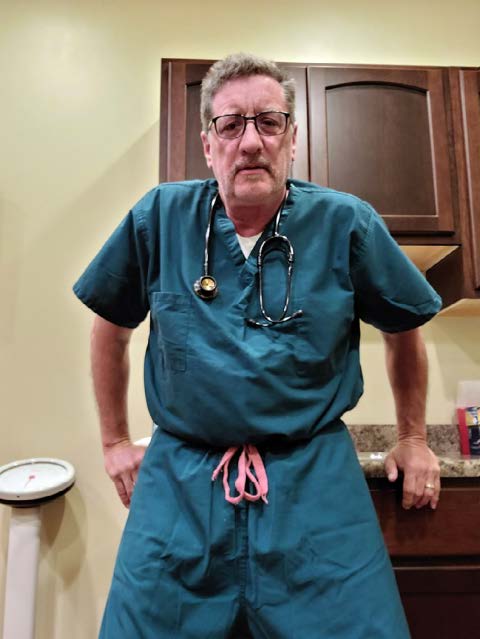
CHANGE YOUR SHOES
"IT'S NOT WHAT YOU WEAR, IT'S HOW YOU WEAR THEM."
BY CARL LANGE, MD
Introduction: Dr. Carl Lange is an emergency medicine physician and emergency department director in Pittsburgh. He acknowledges that, like most physicians, he received no formal training in treating patients with intellectual and developmental disabilities. His teachers have been the patients themselves, their families, and caregivers. He is quick to add that his own diagnosis of multiple sclerosis has greatly contributed to his insights, empathy, understanding and appreciation of how a disability can impact on social roles, outcomes, expectations, perceptions, outlooks and relationships. — Rick Rader, MD, Editor-in-Chief, EP Magazine
"You can burn my house, steal my car, drink my liquor from an old fruit jar. Well do anything that you want to do, but uh-uh, honey lay off of my shoes." Shoes are an essential apparatus in our daily lives. At least according to the King, Elvis Presley who was willing to go to great lengths to protect his.
In 1938, deep within the recesses of an Oregon cave, archeologists discovered a shoe-like object dating back to approximately 3500 BC. The sole was fabricated with bear skin and the sides fortified by deer skin. The device was woven together with bark-string netting which, in essence, served to pull the "foot-bags" together to protect our ancestors' tootsies. Scientists don't know for sure if they had cars, or stored their liquor in old fruit jars, but they did concur with Elvis on the weightiness of footwear. Now, while they in no way resemble Bruno Cucinellis, they served a purpose.
Designed by our predecessors for the purpose of protection from the cold, the adversities of the elements of their time, rocks and debris, shoes were more for function than style. Fast forward to 2020, where some footwear can cost the fashion-conscious buyer upwards of fifty-thousand dollars. All for the purpose of looking good while having the security of knowing that your feet are shielded from the terrors of the outside world. So, all that being said, why so many brands and styles? The simple answer is that people have many different opinions on exactly what does look good in addition to what is comfortable and practical. Do you mean to tell me that Homo Sapiens are capable of having varied perspectives on the world and the situations that life presents to us? That's right folks. When we look at Mars in the night sky with our naked eye, it looks much different than peering at the Angry Red Planet from the Hubble telescope. Or, how about this? If NASA were to set you down on the surface of the planet, open the door and let you outside, for the fraction of a second that you had left in your life, it would certainly look and feel much different.
It's all a matter of perspective. Albert Einstein was quoted as saying that "When you are courting a nice girl, an hour seems like a second. When you sit on a red-hot cinder a second seems like an hour." So, it seems like your perspective is dictated by your view of the situation. A genius said that, not me.
As an emergency room physician in a busy Pittsburgh hospital, I see thousands of patients a month. The spectrum of acuity ranges from minor coughs and colds to gunshot victims, heart attacks, and strokes. My job gives me the affordance of treating many patients with special needs, or a term I abhor, "disabilities". Because as we know, what one man considers a disability, another would view it as a gift that allows one to accomplish life in a different manner, often creating good along the way. But, since you are reading this, we already agree on this fact.

BODY AND SOLE: On August 26th, 2008, I lost my vision while working in the emergency room. Things sure did "look" different then. The regaining of my sight and rehabilitation took about ten days. The rehabilitation of my soul took much less time.
Twelve years ago, I was diagnosed with multiple sclerosis. This disease is insidious and evil. It attacks your nervous system causing you blindness, muscle spasm, spasticity and pain. I have difficulty walking, among other symptoms. I have gone blind twice, requiring hospitalization. Please understand me. I am in no way singing the blues because I truly consider myself a blessed man. I share this very personal history with you merely to highlight this theory of relativity of which we speak. My job requires me to walk up and down hospital corridors for twelve-plus hours, to "run" to cardiac arrests, and respond in a split second to a gun-shot wound. This brings this whole discussion to the historical timeline outlining PMS verses PMS (pre-multiple sclerosis versus post-multiple sclerosis).
I am ashamed to admit that there was more than one occasion when I saw a patient with multiple sclerosis in my emergency department who I looked upon with a jaundiced eye as a gamer of the system. The thought of this patient trying to scam me out of pain medicine or muscle relaxants was never far from my list of differential diagnoses. Of course, I ran the proper tests and did the proper physical exam, but I always felt bothered by the very fact that this concept even entered my mind. That is, until August 26th, 2008, when I lost my vision while working in the very emergency room of which I speak. Things sure did "look" different then. The regaining of my sight and rehabilitation took about ten days. The rehabilitation of my soul took much less time. Hearing my radiologist colleague and friend tell me "I'm sorry to have to tell you Carl, you have multiple sclerosis" did not heal my vision, but instantaneously healed my outlook, so to speak.
When I eventually attained my ability to see again, I got back to work. Not only was I able to see my patient in front of me, but now I could clearly see the person in front of me.
We've all heard the metaphor "Never criticize a man until you have walked a mile in his shoes." So, never wanting to become too comfortable in my footwear, I'll excuse myself now. I'm going to the mall to buy a new pair of shoes. •
ABOUT THE AUTHOR:
Dr. Carl Lange is an Emergency Medicine physician practicing in Pittsburgh, Pennsylvania. He is Board Certified by the American Board of Surgery and works with University of Pittsburgh Physicians at The University of Pittsburgh Medical Center.